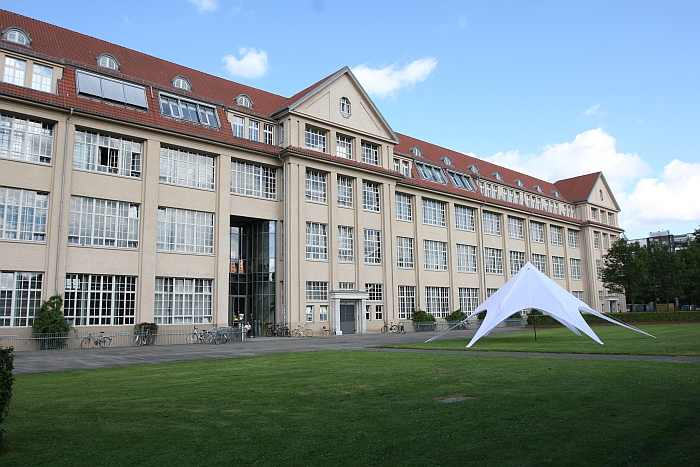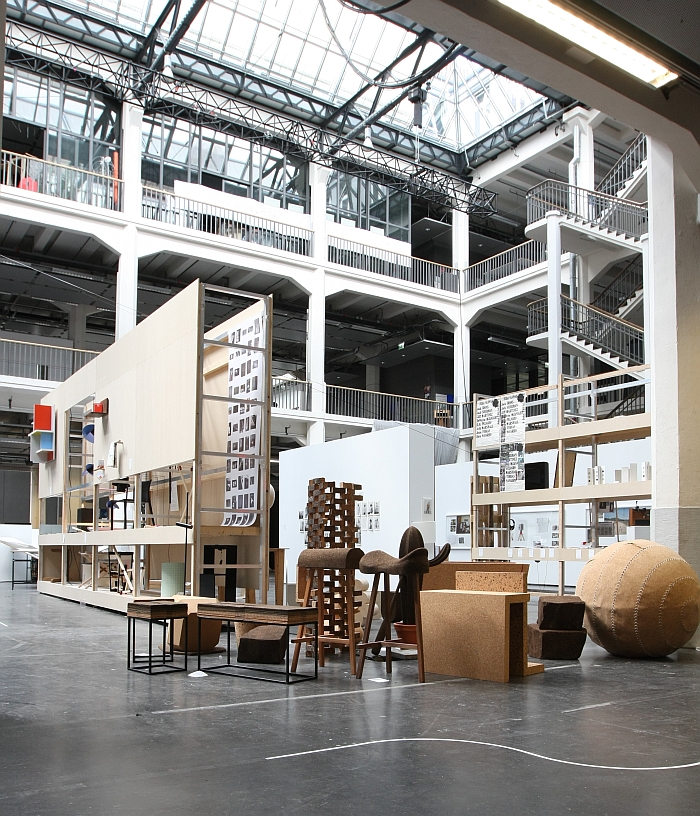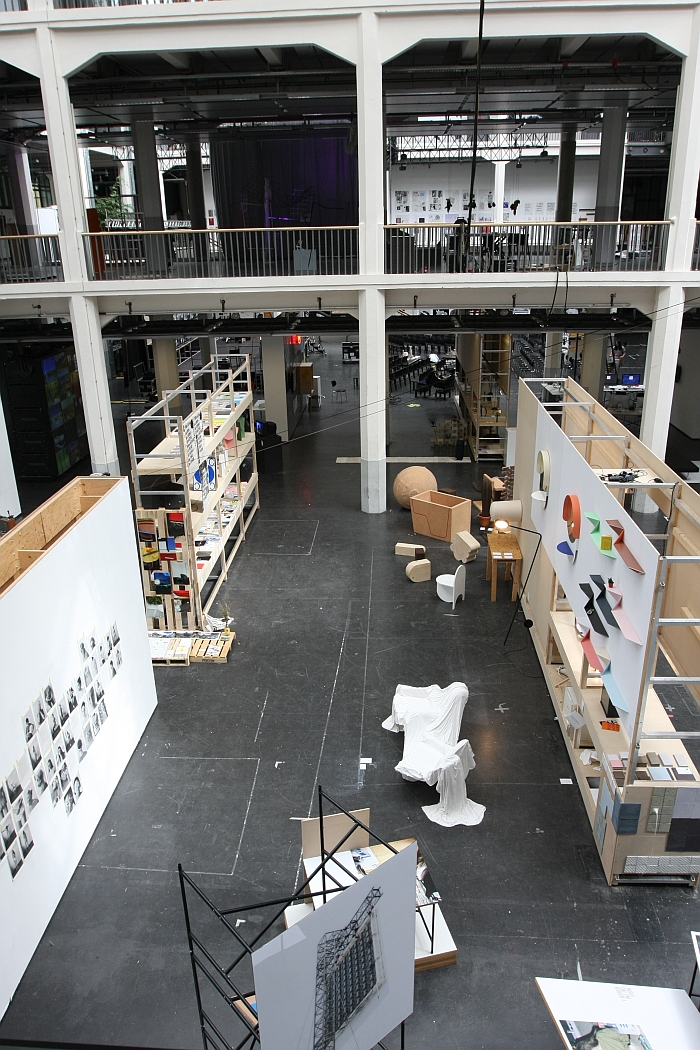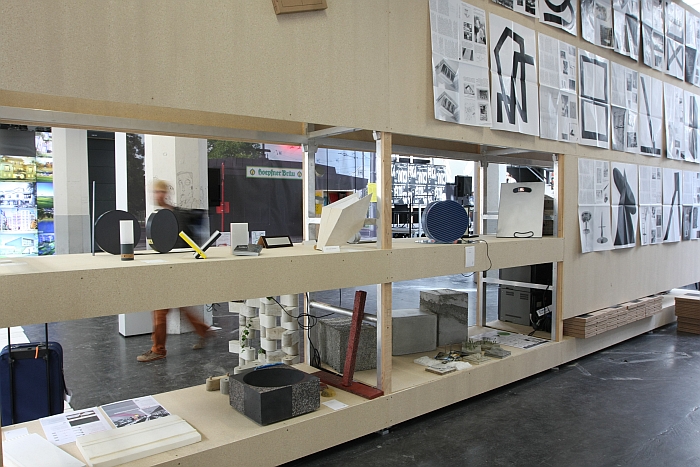Hochschule für Gestaltung Karlsruhe – Rundgang durch die Lichthöfe 2016
If a central component of the Bauhaus philosophy was, in essence, to make art useful for industrial production and thus give art a contemporary relevance and function, what to do in a post-industrial world?* The answer from the German art historian and architecture theorist Heinrich Klotz was to unify art with digital technology, and thus give art a contemporary relevance and function.
Or the Zentrum für Kunst und Medientechnologie Karlsruhe, to give it its formal name; and an institution which subsequently gave rise to the neighbouring Hochschule für Gestaltung Karlsruhe.
Hochschule für Gestaltung Karlsruhe
Established in 1989 the Zentrum für Kunst und Medientechnologie – Centre for Art and Media Technology – is a combination of digital media museum, laboratories and studios which in addition to archiving and explaining the history of digital media and digital technology also understands itself as a platform for both research into contemporary aspects of digital media and also for the production and realisation of new projects – in which context an important element of the wider institution is the Hochschule für Gestaltung Karlsruhe.
Formally opened on April 15th 1992 the Hochschule für Gestaltung, HfG, Karlsruhe primarily owes its existence to the position of the Zentrum für Kunst und Medientechnologie, ZKM’s, founding director Heinrich Klotz, that education was just as important as presentation and research, and thus that if Karlsruhe was going to develop as a centre where “traditional” art and “contemporary” digital media existed as equals and in a fashion where one enriched, enlivened and advanced the other, then a college was an essential to allow for a close co-operation and exchange of ideas between the established and the contemporary and between theory and practice.
Although often considered as an “electronic Bauhaus” Heinrich Klotz understood the HfG Karlsruhe much more as an “electronic HfG Ulm”, or perhaps better put, as being the next logical link in an evolutionary chain that started with Bauhaus, was updated and intensified by the HfG Ulm and which achieved its next logical metamorphosis in the HfG Karlsruhe and in particular the realisation of what Heinrich Klotz refers to as a Zweite Moderne – a Second Modernism.
The First Modernism having developed for the industrial age, the second for the digital. The third? That’s still very much open, and in any case we first of all need to get through the inevitable stylistic confusion of the coming post-digital era…..
In addition to offering courses of study in areas such as Media Art, Communication Design or Product Design a further important column on which the HfG Karlsruhe is built is Art Research and Media Philosophy; as such it is perhaps no accident that the Product Design Department at the HfG Karlsruhe has been led since 1994 by Professor Volker Albus, a designer and architect widely considered not only one of the most important theoreticians of the post-modern – or post-first-modern to remain true to Heinrich Klotz’s position – Neue Deutsche Design of the 1980s, but of German design since the 1980s.
The course of studies at the HfG Karlsruhe is project based, mixed across years and specialisations and every student is free to develop their course of studies as they see fit.
And despite the school’s grounding principle of the importance of digital media, that doesn’t mean that design students from the HfG Karlsruhe only produce digital products or lose themselves in the ceaseless creation of ever more Apps for ever more specific, niche, and thoroughly unimportant, areas of our lives. Far from it. Much more the considerations of and with contemporary media tend to take place in context of contemporary understandings of the relevance and function of design and architecture, rather than a direct application of digital technology. And indeed some of the most inspired analogue student projects we have seen originate from Karlsruhe. As ever, we refer the interested reader to the college’s kkaarrlls collection.
A taste for what students at the Hochschule für Gestaltung Karlsruhe have undertaken over the past year could be had at the 2016 Rundgang durch die Lichthöfe 2016 end of term exhibition
Hochschule für Gestaltung Karlsruhe – Rundgang durch die Lichthöfe 2016
As a project based course of studies the main focus of the 2016 Rundgang was such projects, among the most interesting of which for us were, LED/OLED it move! undertaken in cooperation with Stuttgart based lighting manufacturer NIMBUS and which sought concepts for transportable, battery powered lights; BETON – “Metamorphosen” – Concrete – “Metamorphoses – with Volker Albus and which took its impulse from the Concrete Design Competition ran by the German Concrete Information Centre and which sought new ideas for working with the variability inherent in concrete as a material; or SKIN, die Macht der Oberfläche – SKIN, The Power of the Surface Material – by and with Kilian Schindler in which the current obsession – our word not the HfG’s – of the furniture industry with presenting established products in new material finishes and/or colour pallets and calling it a “new” product was placed under a conceptual microscope.
In addition the 2016 Rundgang provided a very welcome wiedersehen with the project Old World – New World which sought contemporary applications for cork, and we were also very taken with the wilful, and extremely humorous, misappropriation of Egon Eiermann’s table frame for exhibition design purposes. Having never met Professor Eiermann we can’t be 100% certain if he himself would necessarily have agreed with the idea; but given that he developed his table frame in Karlsruhe, and for use by Karlsruhe students, even if of the TU rather than HfG genus, we can think of no more appropriate place for such a development of the object. Nor a better example of the complexity that can exist with the simplest system.
If we did have one complaint it would be the three metre high presentation walls: yes the Aula of the HfG Karlsruhe has the space for such, but they did make it ridiculously difficult to properly view projects up high. Unless you happen to be three metres tall. Which we aren’t. Thus there were a couple of projects which from our terrestrial position looked very promising, but….
However, despite such considerations the 2016 Rundgang durch die Lichthöfe provided a concise, if thought-provoking, entertaining and highly informative insight into not only the work undertaken by HfG Karlsruhe students but the approach undertaken by the teaching staff to support and encourage that work, and the school’s pedagogical position. And that is ultimately what make such presentations valuable, interesting and worth visiting
Full details on the Hochschule für Gestaltung Karlsruhe can be found at www.hfg-karlsruhe.de
* An interesting theoretical question in this context of course is if one can have a post-art world? Or does the fact that art exists for itself mean that it cannot not exist?
Tagged with: Hochschule für Gestaltung Karlsruhe, Karlsruhe, Rundgang





